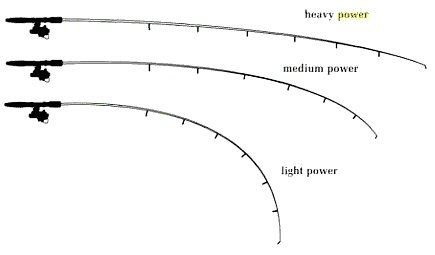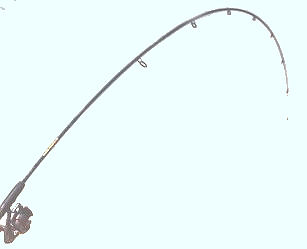
Fishing Rod Power is the amount of energy it can accumulate and give back.

- UL - Ultra-Light
- L - Light
- ML - Med/Light
- M - Medium
- MH - Medium Heavy
- H - Heavy
- XH - Extra Heavy
- UH - Ultra Heavy
Ultra-light fishing rods are best for catching small bait fish like panfish. Extra-Heavy rods are used for heavy fish in surf fishing, deep sea fishing. Any fish can be caught with any rod, but catching panfish on a heavy rod offers no fun at all, and successfully landing a large fish on an ultra-light rod requires highest rod handling skills at best, and a fun you got is the best fun you can have but more frequently it ends in broken tackle and a lost fish. The best if rods are matched to the type of fishing they are intended for. The smaller the fish you target, the lighter the rod you will need. Panfish should be fished with either an Ultra Light or a Light rod, while you better use Heavy or Extra Heavy rod to cast large lures and fight some powerful and heavy fish like big musky.
The lure weights and line sizes that a rod can handle determine its power. Ultra-light rods are designed for 2-6 pound line and lures weighing from 1/32-ounce. The following list details the types of rod power, and the corresponding line and lure weight they would be best matched up with.

Ultra Light
Light
Medium
Medium Heavy
Heavy
Extra Heavy
1 to 4lb Test
4 to 8lb Test
4 to 12lb Test
8 to 14lb Test
15 - 25lb Test
25lb Test and Above
1/64 - 1/16oz
1/32 - 1/8oz
1/8 - 3/8oz
3/16 - 1/2 oz
up to 1 1/2 oz
1 1/2 oz and Above
Rod power is the rod's strength or ability to lift weight from the tip; it is the amount of force needed to bend the rod. The thickness and type of rod material will determine this. Power ratings are mostly reflective of the rod's application, a heavy power rod would be suited for offshore trolling and a medium power rod might be designed for surf casting. Power describes the strength of the rod or its lifting power. Power is closely related to the line strength Power (to recommended line weight); heavier power rods will handle heavy line weights and lighter powers will be good for light lines. It is fairly important to keep your line test within the limits printed on the rod since a heavy power rod will snap light lines too easily and heavy lines can snap a light rod. Power ratings vary by the type of rod described; a heavy bass rod and a heavy offshore rod will definitely not feel the same. One might be rated for 25lb line and the other for 80lb line.
The type of water you're fishing will help determine the power of the rod you should select. Thick, heavy cover will require a strong rod to get the fish out before it can tie you up. Clear, open water will often require thin, hard seeing lines in order to get bit, meaning you will need a lighter power rod. Power refers to the blank's resistance to flexing under load. The Newton's third law: For every action there is an equal and opposite reaction.
Resistance to flexing is a natural design characteristic based upon the taper and wall thickness of the blank. The power for blanks may range from Ultra-Light to Heavy to even Extra Heavy. The power of a rod is simply a rating, which describes the overall stiffness of the blank.
Action and Power are not the same and cannot be used interchangeably as some think. A lot of rod manufactures and anglers get this confused with action. Most rods when marked light-action is referring to power not action. The best way to tell the power of a rod is to check the line weight ratings.
Action refers to rod flex and Power refers the rod's resistance to flexing. Using the design criteria and inherent characteristics of a blank will aid in specific techniques and presentations. Using blank characteristics to your advantage will provide you the benefit of making the most out of every opportunity to land fish. The discussion around technique application will center on Action as opposed to Power. Both traits are designed into the blank by the manufacturer, but action will be the most critical characteristic when discussing and evaluating techniques and presentations.
For Bluegill, Crappie and small Trout, a light power, fast action spinning rod is a good choice. A quality ultra-light rod also works for these fish, but many ultra-lights are too short and too wimpy. A 4.5-foot ultra-light rod with the backbone of a boiled noodle isn't worth the packaging it came in for any species.
For larger Black Bass, Walleye and Channel Catfish, a medium power, moderate fast or fast action baitcasting rod works well. Baitcasting reels have an enclosed spool and mount on top of the rod. They are the best choice for lines of 10 pound test or higher. They require much greater practice than spinning gear to use effectively.
Choose the moderate fast action if you plan to fish leeches or minnows for Walleye, or chicken livers for Channel cats. The slightly softer action usually helps prevent you from throwing off the bait while casting. If you plan to jig and worm fish for Largemouth Bass and occasionally fish for the other species, choose a fast action, medium power rod.
Get a medium heavy or heavy power baitcasting rod with a fast action for Striped Bass, Muskellunge, Flathead Catfish and Blue Catfish. This set-up is also good for flipping or pitching jigs for Largemouth Bass. Choose a moderate or slow action rod with a medium-heavy or heavy power rating if you plan to use live bait. Again, the softer action protects against throwing the bait off the hook on the cast. These rods possess enough strength to land these fish, but they can also handle the heavy lures and strong line needed.
Back to top


































